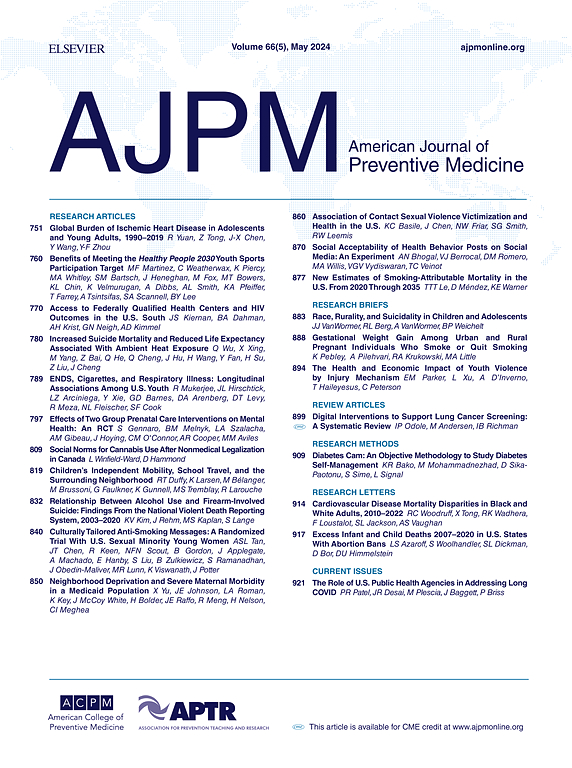Quit Attempts and Use of Cessation Aids Among U.S. Adults Who Smoke Nondaily
IF 4.3
2区 医学
Q1 MEDICINE, GENERAL & INTERNAL
引用次数: 0
Abstract
Introduction
About 25% of people who currently smoke cigarettes in the U.S. smoke nondaily, and relatively little is known about their intentions or attempts to quit. Active surveillance is essential to identify services needed to support smoking cessation efforts and reduce the burden of disease.
Methods
U.S. population-wide estimates of quit attempts and use of cessation aids among adults who smoke cigarettes were calculated using data from the September 2022 wave of the Tobacco Use Supplement to the Current Population Survey. Statistical analyses were conducted in 2024. Weighted percentages and 95% CIs are presented by sociodemographic characteristics and smoking pattern.
Results
In 2022, nearly 6 million adults (2.59 million women, 3.36 million men) in the U.S. reported smoking nondaily an average of 13.4 days per month (95% CI=12.7, 14.1). Compared with adults who smoke daily, the proportion of past-year quit attempts was higher among people who reported smoking on some days of the month (always some days: 41.8%; formerly daily: 58.4%; daily: 32.2%). However, those who smoke some days were less likely to report receiving medical advice to quit (always some days: 49.5%; formerly daily: 58.1%; daily: 72.7%), using pharmacotherapy such as nicotine replacement therapy or a prescribed medication (always some days: 17.9%; formerly daily: 32.4%; daily: 38.7%), or receiving counseling to quit smoking (always some days: 5.8%; formerly daily: 6.9%; daily: 12.0%).
Conclusions
Given the substantial number of adults who smoke nondaily in the U.S. and their interest in quitting, developing targeted interventions and communication is an important public health priority.
美国非每日吸烟成年人的戒烟尝试和戒烟辅助工具的使用情况。
导言:美国目前约有 25% 的吸烟者并非每天吸烟,而人们对他们的戒烟意愿或戒烟尝试知之甚少。积极的监测对于确定支持戒烟努力和减少疾病负担所需的服务至关重要:方法:利用《当前人口调查烟草使用补充资料》2022 年 9 月的数据,计算了美国全人口中吸烟成人的戒烟尝试和使用戒烟辅助工具的估计值。统计分析于 2024 年进行。按社会人口特征和吸烟模式列出了加权百分比和 95% 置信区间 (95%CI):2022 年,美国有近 600 万成年人(259 万女性,336 万男性)表示每月平均有 13.4 天(95%CI:12.7-14.1)非每天吸烟。与每天吸烟的成年人相比,每月有几天吸烟的人在过去一年中尝试戒烟的比例更高(总是有几天吸烟:41.8%;以前每天吸烟:58.4%;每天吸烟:32.2%)。然而,在某些日子吸烟的人群中,接受戒烟医学建议(总是某些日子:49.5%;以前每天:58.1%;每天:72.7%)、使用尼古丁替代疗法或处方药等药物疗法(总是某些日子:17.9%;以前每天:32.4%;每天:38.7%)或接受戒烟咨询(总是某些日子:5.8%;以前每天:6.9%;每天:12.0%)的比例较低:鉴于美国非每天吸烟的成年人人数众多,而且他们对戒烟很感兴趣,因此制定有针对性的干预措施和进行宣传是公共卫生工作的重中之重。
本文章由计算机程序翻译,如有差异,请以英文原文为准。
求助全文
约1分钟内获得全文
求助全文
来源期刊

American Journal of Preventive Medicine
医学-公共卫生、环境卫生与职业卫生
CiteScore
8.60
自引率
1.80%
发文量
395
审稿时长
32 days
期刊介绍:
The American Journal of Preventive Medicine is the official journal of the American College of Preventive Medicine and the Association for Prevention Teaching and Research. It publishes articles in the areas of prevention research, teaching, practice and policy. Original research is published on interventions aimed at the prevention of chronic and acute disease and the promotion of individual and community health.
Of particular emphasis are papers that address the primary and secondary prevention of important clinical, behavioral and public health issues such as injury and violence, infectious disease, women''s health, smoking, sedentary behaviors and physical activity, nutrition, diabetes, obesity, and substance use disorders. Papers also address educational initiatives aimed at improving the ability of health professionals to provide effective clinical prevention and public health services. Papers on health services research pertinent to prevention and public health are also published. The journal also publishes official policy statements from the two co-sponsoring organizations, review articles, media reviews, and editorials. Finally, the journal periodically publishes supplements and special theme issues devoted to areas of current interest to the prevention community.
 求助内容:
求助内容: 应助结果提醒方式:
应助结果提醒方式:


